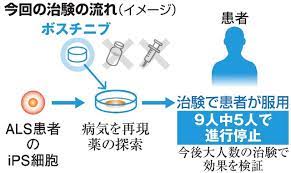
京都大学:用 iPS 细胞重现顽固性 ALS:治疗药物“博舒替尼”
-希望治疗药物,京都大学临床试验-
京都大学队:
使用 iPS 细胞,重现了顽固性疾病“肌萎缩侧索硬化症(ALS)”的状况。
发现有效治疗白血病的方法:
作为寻找 ALS 治疗候选者的研究结果,我们发现了一种有效的白血病治疗方法。
京都大学9月26日宣布。
京都大学的一个团队开始了 ALS 的临床试验。
ALS临床试验开始:
临床试验是获得公共医疗保险的必要程序。
瞄准ALS治疗药物的实际应用,我们已经开始行动。
治疗药物“博舒替尼”:
该药物是“博舒替尼”,一种治疗慢性粒细胞白血病的药物。
每天口服一次,持续 12 周。
将在京都大学医院等4家医疗机构的24人中实施。
用于 24 名 ALS 患者:
它适用于发病后 2 年内 20 至 79 岁的患者。
ALS 症状正在恶化,
另一方面,我仍然可以工作
这适用于可以做家务的人。
日本ALS患者:
日本约有 9,000 名 ALS 患者。
肌肉力量减弱,移动变得越来越困难。
有些药物可以减缓进展,但没有确定的治愈方法。
朝日新闻数码
https://www.asahi.com/articles/ASM3V3S6PM3VPLBJ001.html
Announcement of a clinical trial for amyotrophic lateral sclerosis (ALS)
Center for iPS Cell Research and Application (CiRA), Kyoto University,
has announced a new Phase 1*1) clinical trial for the drug bosutinib to treat amyotrophic lateral sclerosis (ALS) at the Kyoto University Hospital (KUH).
Leading the project from CiRA is Professor Haruhisa Inoueand from KUH is Professor Ryosuke Takahashi.
This trial has received approval from the Japanese Pharmaceuticals and Medical Devices Agency (PMDA).
News and Events | CiRA | Center for iPS Cell Research and Application, Kyoto University
https://www.cira.kyoto-u.ac.jp/e/pressrelease/news/190403-110000.html
Deep learning amyotrophic lateral sclerosis by taking pictures
A team of scientists led by CiRA Professor Haruhisa Inoue
reports the combination of deep learning and iPS cell technology for the diagnosis of amyotrophic lateral sclerosis (ALS).
Recently, researchers have reported that
deep learning could potentially identify individuals at risk for Alzheimer’s disease (https://www.nytimes.com/2021/02/01/health/alzheimers-prediction-speech.html).
In the new study on ALS seen in Annals of Neurology,
Inoue and colleagues show how deep learning can be used to identify indications of ALS,
a relentless motor neuron disease, by using iPS cell technology to reprogram patient blood cells into motor neurons, the cells most afflicted by the disease.
Convolutional neural networks
were trained using images of motor neurons prepared from the iPS cells of 15 healthy donors and 15 ALS patients.
Based on just images of motor neurons,
the network could predict with over 0.97 of area under curve (AUC) whether other donors were healthy or ALS patients.
On the other hand,
conventional machine learning with the same images,focusing on soma size, neurite length, and cell number, presented approximately 0.97 of AUC (see figure).
News and Events | CiRA | Center for iPS Cell Research and Application, Kyoto University
https://www.cira.kyoto-u.ac.jp/e/pressrelease/news/210224-100000.html